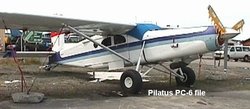Thu, Jan 13, 2011
AD NUMBER: 2009-18-03 R1
MANUFACTURER: Pilatus Aircraft Ltd. Models
PC-6, PC- 6-H1, PC-6-H2, PC-6/350, PC-6/350-H1, PC-6/350-H2,
PC-6/A, PC-6/A-H1, PC-6/A-H2, PC-6/B-H2, PC-6/B1-H2, PC-6/B2-H2,
PC-6/B2-H4, PC-6/C-H2, and PC-6/C1-H2
SUBJECT: Airworthiness Directive 2009-18-03 R1

SUMMARY: This AD results from mandatory
continuing airworthiness information (MCAI) issued by an aviation
authority of another country to identify and correct an unsafe
condition on an aviation product. The MCAI describes the unsafe
condition as:
Findings of corrosion, wear and cracks in the upper wing strut
fittings on some PC-6 aircraft have been reported in the past. It
is possible that the spherical bearing of the wing strut fittings
installed in the underwing can be loose in the fitting or cannot
rotate because of corrosion. In this condition, the joint cannot
function as designed and fatigue cracks may then develop.
Undetected cracks, wear and/or corrosion in this area could cause
failure of the upper attachment fitting, leading to failure of the
wing structure and subsequent loss of control of the
aircraft.
To address this problem, FOCA published AD TM-L Nr. 80.627-6/ Index
72-2 and HB-2006-400 and EASA published AD 2007-0114 to require
specific inspections and to obtain a fleet status. Since the
issuance of AD 2007-0114, the reported data proved that it was
necessary to establish and require repetitive inspections.
EASA published Emergency AD 2007-0241-E to extend the applicability
and to require repetitive eddy current and visual inspections of
the upper wing strut fitting for evidence of cracks, wear and/or
corrosion and examination of the spherical bearing and replacement
of cracked fittings. Collected data received in response to
Emergency AD 2007-0241-E resulted in the issuance of EASA AD
2007-0241R1 that permitted extending the intervals for the
repetitive eddy current and visual inspections from 100 Flight
Hours (FH) to 300 FH and from 150 Flight Cycles (FC) to 450 FC,
respectively. In addition, oversize bolts were introduced by
Pilatus PC-6 Service Bulletin (SB) 57-005 R1 and the fitting
replacement procedure was adjusted accordingly.
Based on fatigue test results, EASA AD 2007-0241R2 was issued to
extend the repetitive inspection interval to 1100 FH or 12 calendar
months, whichever occurs first, and to delete the related flight
cycle intervals and the requirement for the "Mild Corrosion
Severity Zone'. In addition, some editorial changes have been made
for reasons of standardization and readability.
Revision 3 of this AD referred to the latest revision of the PC- 6
Aircraft Maintenance Manual (AMM) Chapter 5 limitations which have
included the same repetitive inspection intervals and procedures
already mandated in the revision 2 of AD 2007-0241. Besides the
inspections, in the latest revision of the PC-6 AMM, the
replacement procedures for the fittings were included.
Additionally, EASA AD 2007-0241R3 introduced the possibility to
replace the wing strut fitting with a new designed wing strut
fitting. With this optional part replacement, in the repetitive
inspection procedure the 1100 FH interval is deleted so that only
calendar defined intervals of inspections remained applicable.
More News
Terminal Radar Service Area Airspace surrounding designated airports wherein ATC provides radar vectoring, sequencing, and separation on a full-time basis for all IFR and participa>[...]
Very High Frequency (VHF) The frequency band between 30 and 300 MHz. Portions of this band, 108 to 118 MHz, are used for certain NAVAIDs; 118 to 136 MHz are used for civil air/grou>[...]
“From approximately November 2021 through January 2022, Britton-Harr, acting on behalf of AeroVanti, entered into lease-purchase agreements for five Piaggio-manufactured airc>[...]
Also: Virtual FLRAA Prototype, IFR-Capable Autonomous A/C, NS-32 Crew, Golden Dome Missile Defense Bombardier announced that the first production Global 8000 successfully completed>[...]
Aero Linx: The 1-26 Association (Schweizer) The Association’s goal is to foster the helpfulness, the camaraderie, and the opportunity for head-to-head competition that is fou>[...]
 ANN's Daily Aero-Term (05.29.25): Terminal Radar Service Area
ANN's Daily Aero-Term (05.29.25): Terminal Radar Service Area ANN's Daily Aero-Term (05.30.25): Very High Frequency (VHF)
ANN's Daily Aero-Term (05.30.25): Very High Frequency (VHF) Aero-News: Quote of the Day (05.30.25)
Aero-News: Quote of the Day (05.30.25) Airborne 05.23.25: Global 8000, Qatar B747 Accepted, Aviation Merit Badge
Airborne 05.23.25: Global 8000, Qatar B747 Accepted, Aviation Merit Badge ANN's Daily Aero-Linx (05.30.25)
ANN's Daily Aero-Linx (05.30.25)



